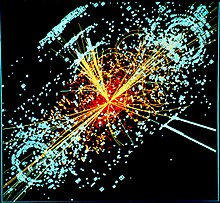| Composition | Elementary particle |
|---|---|
| Family | Gauge boson |
| Interactions | Gravitation |
| Status | Hypothetical |
| Antiparticle | Self |
| Theorized | 2000s[1][2] |
| Electric charge | 0 e |
| Spin | 2 |
| String theory |
|---|
 |
| Fundamental objects |
| Perturbative theory |
| Non-perturbative results |
| Phenomenology |
| Mathematics |
| Beyond the Standard Model |
|---|
 |
| Standard Model |
In theoretical physics, the dual graviton is a hypothetical elementary particle that is a dual of the graviton under electric-magnetic duality, as an S-duality, predicted by some formulations of eleven-dimensional supergravity.[3]
The dual graviton was first hypothesized in 1980.[4] It was theoretically modeled in 2000s,[1][2] which was then predicted in eleven-dimensional mathematics of SO(8) supergravity in the framework of electric-magnetic duality.[3] It again emerged in the E11 generalized geometry in eleven dimensions,[5] and the E7 generalized vielbein-geometry in eleven dimensions.[6] While there is no local coupling between graviton and dual graviton, the field introduced by dual graviton may be coupled to a BF model as non-local gravitational fields in extra dimensions.[7]
A massive dual gravity of Ogievetsky–Polubarinov model[8] can be obtained by coupling the dual graviton field to the curl of its own energy-momentum tensor.[9][10]
The previously mentioned theories of dual graviton are in flat space. In de Sitter and anti-de Sitter spaces (A)dS, the massless dual graviton exhibits less gauge symmetries dynamics compared with those of Curtright field in flat space, hence the mixed-symmetry field propagates in more degrees of freedom.[11] However, the dual graviton in (A)dS transforms under GL(D) representation, which is identical to that of massive dual graviton in flat space.[12] This apparent paradox can be resolved using the unfolding technique in Brink, Metsaev, and Vasiliev conjecture.[13][14] For the massive dual graviton in (A)dS, the flat limit is clarified after expressing dual field in terms of the Stueckelberg coupling of a massless spin-2 field with a Proca field.[11]
Dual linearized gravity
[edit]The dual formulations of linearized gravity are described by a mixed Young symmetry tensor , the so-called dual graviton, in any spacetime dimension D > 4 with the following characters:[2][15]
where square brackets show antisymmetrization.
For 5-D spacetime, the spin-2 dual graviton is described by the Curtright field . The symmetry properties imply that
The Lagrangian action for the spin-2 dual graviton in 5-D spacetime, the Curtright field, becomes[2][15]
where is defined as
and the gauge symmetry of the Curtright field is
The dual Riemann curvature tensor of the dual graviton is defined as follows:[2]
and the dual Ricci curvature tensor and scalar curvature of the dual graviton become, respectively
They fulfill the following Bianchi identities
where is the 5-D spacetime metric.
Massive dual gravity
[edit]In 4-D, the Lagrangian of the spinless massive version of the dual gravity is
where [16] The coupling constant appears in the equation of motion to couple the trace of the conformally improved energy momentum tensor to the field as in the following equation
And for the spin-2 massive dual gravity in 4-D,[10] the Lagrangian is formulated in terms of the Hessian matrix that also constitutes Horndeski theory (Galileons/massive gravity) through
where .
So the zeroth interaction part, i.e., the third term in the Lagrangian, can be read as so the equation of motion becomes
where the is Young symmetrizer of such SO(2) theory.
For solutions of the massive theory in arbitrary N-D, i.e., Curtright field , the symmetrizer becomes that of SO(N-2).[9]
Dual graviton coupling with BF theory
[edit]Dual gravitons have interaction with topological BF model in D = 5 through the following Lagrangian action[7]
where
Here, is the curvature form, and is the background field.
In principle, it should similarly be coupled to a BF model of gravity as the linearized Einstein–Hilbert action in D > 4:
where is the determinant of the metric tensor matrix, and is the Ricci scalar.
Dual gravitoelectromagnetism
[edit]In similar manner while we define gravitoelectromagnetism for the graviton, we can define electric and magnetic fields for the dual graviton.[17] There are the following relation between the gravitoelectric field and gravitomagnetic field of the graviton and the gravitoelectric field and gravitomagnetic field of the dual graviton :[18][15]
and scalar curvature with dual scalar curvature :[18]
where denotes the Hodge dual.
Dual graviton in conformal gravity
[edit]The free (4,0) conformal gravity in D = 6 is defined as
where is the Weyl tensor in D = 6. The free (4,0) conformal gravity can be reduced to the graviton in the ordinary space, and the dual graviton in the dual space in D = 4.[19]
It is easy to notice the similarity between the Lanczos tensor, that generates the Weyl tensor in geometric theories of gravity, and Curtright tensor, particularly their shared symmetry properties of the linearized spin connection in Einstein's theory. However, Lanczos tensor is a tensor of geometry in D=4,[20] meanwhile Curtright tensor is a field tensor in arbitrary dimensions.
See also
[edit]- Graviton
- Gravitino
- Gravity
- Gravitoelectromagnetism
- Curtright field
- Taub–NUT space
- Nielsen–Olesen vortex
- 't Hooft loop
- Dual photon
- Massive gravity
- Horndeski's theory
- List of hypothetical particles
References
[edit]- ^ a b Hull, C. M. (2001). "Duality in Gravity and Higher Spin Gauge Fields". Journal of High Energy Physics. 2001 (9): 27. arXiv:hep-th/0107149. Bibcode:2001JHEP...09..027H. doi:10.1088/1126-6708/2001/09/027.
- ^ a b c d e Bekaert, X.; Boulanger, N.; Henneaux, M. (2003). "Consistent deformations of dual formulations of linearized gravity: A no-go result". Physical Review D. 67 (4): 044010. arXiv:hep-th/0210278. Bibcode:2003PhRvD..67d4010B. doi:10.1103/PhysRevD.67.044010. S2CID 14739195.
- ^ a b de Wit, B.; Nicolai, H. (2013). "Deformations of gauged SO(8) supergravity and supergravity in eleven dimensions". Journal of High Energy Physics. 2013 (5): 77. arXiv:1302.6219. Bibcode:2013JHEP...05..077D. doi:10.1007/JHEP05(2013)077. S2CID 119201330.
- ^ Curtright, T. (1985). "Generalised Gauge Fields". Physics Letters B. 165 (4–6): 304. Bibcode:1985PhLB..165..304C. doi:10.1016/0370-2693(85)91235-3.
- ^ West, P. (2012). "Generalised geometry, eleven dimensions and E11". Journal of High Energy Physics. 2012 (2): 18. arXiv:1111.1642. Bibcode:2012JHEP...02..018W. doi:10.1007/JHEP02(2012)018. S2CID 119240022.
- ^ Godazgar, H.; Godazgar, M.; Nicolai, H. (2014). "Generalised geometry from the ground up". Journal of High Energy Physics. 2014 (2): 75. arXiv:1307.8295. Bibcode:2014JHEP...02..075G. doi:10.1007/JHEP02(2014)075.
- ^ a b Bizdadea, C.; Cioroianu, E. M.; Danehkar, A.; Iordache, M.; Saliu, S. O.; Sararu, S. C. (2009). "Consistent interactions of dual linearized gravity in D = 5: couplings with a topological BF model". European Physical Journal C. 63 (3): 491–519. arXiv:0908.2169. Bibcode:2009EPJC...63..491B. doi:10.1140/epjc/s10052-009-1105-0. S2CID 15873396.
- ^ Ogievetsky, V. I; Polubarinov, I. V (1965-11-01). "Interacting field of spin 2 and the einstein equations". Annals of Physics. 35 (2): 167–208. Bibcode:1965AnPhy..35..167O. doi:10.1016/0003-4916(65)90077-1. ISSN 0003-4916.
- ^ a b Alshal, H.; Curtright, T. L. (2019-09-10). "Massive dual gravity in N spacetime dimensions". Journal of High Energy Physics. 2019 (9): 63. arXiv:1907.11537. Bibcode:2019JHEP...09..063A. doi:10.1007/JHEP09(2019)063. ISSN 1029-8479. S2CID 198953238.
- ^ a b Curtright, T. L.; Alshal, H. (2019-10-01). "Massive dual spin 2 revisited". Nuclear Physics B. 948: 114777. arXiv:1907.11532. Bibcode:2019NuPhB.94814777C. doi:10.1016/j.nuclphysb.2019.114777. ISSN 0550-3213. S2CID 198953158.
- ^ a b Boulanger, N.; Campoleoni, A.; Cortese, I. (July 2018). "Dual actions for massless, partially-massless and massive gravitons in (A)dS". Physics Letters B. 782: 285–290. arXiv:1804.05588. Bibcode:2018PhLB..782..285B. doi:10.1016/j.physletb.2018.05.046. S2CID 54826796.
- ^ Basile, Thomas; Bekaert, Xavier; Boulanger, Nicolas (2016-06-21). "Note about a pure spin-connection formulation of general relativity and spin-2 duality in (A)dS". Physical Review D. 93 (12): 124047. arXiv:1512.09060. Bibcode:2016PhRvD..93l4047B. doi:10.1103/PhysRevD.93.124047. ISSN 2470-0010. S2CID 55583084.
- ^ Brink, L.; Metsaev, R.R.; Vasiliev, M.A. (October 2000). "How massless are massless fields in AdS". Nuclear Physics B. 586 (1–2): 183–205. arXiv:hep-th/0005136. Bibcode:2000NuPhB.586..183B. doi:10.1016/S0550-3213(00)00402-8. S2CID 119512854.
- ^ Basile, Thomas; Bekaert, Xavier; Boulanger, Nicolas (May 2017). "Mixed-symmetry fields in de Sitter space: a group theoretical glance". Journal of High Energy Physics. 2017 (5): 81. arXiv:1612.08166. Bibcode:2017JHEP...05..081B. doi:10.1007/JHEP05(2017)081. ISSN 1029-8479. S2CID 119185373.
- ^ a b c Danehkar, A. (2019). "Electric-magnetic duality in gravity and higher-spin fields". Frontiers in Physics. 6: 146. Bibcode:2019FrP.....6..146D. doi:10.3389/fphy.2018.00146.
- ^ Curtright, Thomas L. (2019-10-01). "Massive dual spinless fields revisited". Nuclear Physics B. 948: 114784. arXiv:1907.11530. Bibcode:2019NuPhB.94814784C. doi:10.1016/j.nuclphysb.2019.114784. ISSN 0550-3213. S2CID 198953144.
- ^ Henneaux, M.; Teitelboim, C. (2005). "Duality in linearized gravity". Physical Review D. 71 (2): 024018. arXiv:gr-qc/0408101. Bibcode:2005PhRvD..71b4018H. doi:10.1103/PhysRevD.71.024018. S2CID 119022015.
- ^ a b Henneaux, M., "E10 and gravitational duality" https://www.theorie.physik.uni-muenchen.de/activities/workshops/archive_workshops_conferences/jointerc_2014/henneaux.pdf
- ^ Hull, C. M. (2000). "Symmetries and Compactifications of (4,0) Conformal Gravity". Journal of High Energy Physics. 2000 (12): 007. arXiv:hep-th/0011215. Bibcode:2000JHEP...12..007H. doi:10.1088/1126-6708/2000/12/007. S2CID 18326976.
- ^ Bampi, Franco; Caviglia, Giacomo (April 1983). "Third-order tensor potentials for the Riemann and Weyl tensors". General Relativity and Gravitation. 15 (4): 375–386. Bibcode:1983GReGr..15..375B. doi:10.1007/BF00759166. ISSN 0001-7701. S2CID 122782358.

![{\displaystyle T_{\lambda _{1}\lambda _{2}\cdots \lambda _{D-3}\mu }=T_{[\lambda _{1}\lambda _{2}\cdots \lambda _{D-3}]\mu },}](https://wikimedia.org/api/rest_v1/media/math/render/svg/46f37fdfadcab54a839e5d151582b960ee37c524)
![{\displaystyle T_{[\lambda _{1}\lambda _{2}\cdots \lambda _{D-3}\mu ]}=0.}](https://wikimedia.org/api/rest_v1/media/math/render/svg/5944439471a1e1519848c506ff2c20f69732a595)

![{\displaystyle T_{\alpha \beta \gamma }=T_{[\alpha \beta ]\gamma },}](https://wikimedia.org/api/rest_v1/media/math/render/svg/af6704ce80123b1074813f36d1165a5adcff53a1)
![{\displaystyle T_{[\alpha \beta ]\gamma }+T_{[\beta \gamma ]\alpha }+T_{[\gamma \alpha ]\beta }=0.}](https://wikimedia.org/api/rest_v1/media/math/render/svg/aa3c9bfdc09d31fcc5a2f2afe8c7d0eac552bc3d)

![{\displaystyle {\cal {L}}_{\rm {dual}}=-{\frac {1}{12}}\left(F_{[\alpha \beta \gamma ]\delta }F^{[\alpha \beta \gamma ]\delta }-3F_{[\alpha \beta \xi ]}{}^{\xi }F^{[\alpha \beta \lambda ]}{}_{\lambda }\right),}](https://wikimedia.org/api/rest_v1/media/math/render/svg/97a9e32d283844c5e94928cc75de81ffb92d41f8)

![{\displaystyle F_{[\alpha \beta \gamma ]\delta }=\partial _{\alpha }T_{[\beta \gamma ]\delta }+\partial _{\beta }T_{[\gamma \alpha ]\delta }+\partial _{\gamma }T_{[\alpha \beta ]\delta },}](https://wikimedia.org/api/rest_v1/media/math/render/svg/a7c728a826cfe072713c7b9304f89aaaa034e859)
![{\displaystyle \delta _{\sigma ,\alpha }T_{[\alpha \beta ]\gamma }=2(\partial _{[\alpha }\sigma _{\beta ]\gamma }+\partial _{[\alpha }\alpha _{\beta ]\gamma }-\partial _{\gamma }\alpha _{\alpha \beta }).}](https://wikimedia.org/api/rest_v1/media/math/render/svg/fb03ccb61a9ade8e3f82165cecea4cdbfa044cee)
![{\displaystyle E_{[\alpha \beta \delta ][\varepsilon \gamma ]}\equiv {\frac {1}{2}}(\partial _{\varepsilon }F_{[\alpha \beta \delta ]\gamma }-\partial _{\gamma }F_{[\alpha \beta \delta ]\varepsilon }),}](https://wikimedia.org/api/rest_v1/media/math/render/svg/b8dffdca9870174395bc5facebcfef4bdb1666ba)
![{\displaystyle E_{[\alpha \beta ]\gamma }=g^{\varepsilon \delta }E_{[\alpha \beta \delta ][\varepsilon \gamma ]},}](https://wikimedia.org/api/rest_v1/media/math/render/svg/d349b8c507ad39af9a741c38be38d31c0a450e08)
![{\displaystyle E_{\alpha }=g^{\beta \gamma }E_{[\alpha \beta ]\gamma }.}](https://wikimedia.org/api/rest_v1/media/math/render/svg/14e616f2900100023a1093d4f166683fffe971b8)
![{\displaystyle \partial _{\alpha }(E^{[\alpha \beta ]\gamma }+g^{\gamma [\alpha }E^{\beta ]})=0,}](https://wikimedia.org/api/rest_v1/media/math/render/svg/7a39b98cd8185157fa40c7e0c287abce61371c37)






![{\displaystyle {\text{det}}(\delta _{\nu }^{\mu }+{\frac {g}{m}}K_{\nu }^{\mu })=1-{\frac {1}{2}}(g/m)^{2}K_{\alpha }^{\beta }K_{\beta }^{\alpha }+{\frac {1}{3}}(g/m)^{3}K_{\alpha }^{\beta }K_{\beta }^{\gamma }K_{\gamma }^{\alpha }+{\frac {1}{8}}(g/m)^{4}\left[(K_{\alpha }^{\beta }K_{\beta }^{\alpha })^{2}-2K_{\alpha }^{\beta }K_{\beta }^{\gamma }K_{\gamma }^{\delta }K_{\delta }^{\alpha }\right],}](https://wikimedia.org/api/rest_v1/media/math/render/svg/78c2acec15adc8e176a7effaa872753506c8bf8d)
![{\displaystyle K_{\mu }^{\nu }=3\partial _{\alpha }T_{[\beta \gamma ]\mu }\epsilon ^{\alpha \beta \gamma \nu }}](https://wikimedia.org/api/rest_v1/media/math/render/svg/b04d41b979cb1905467d6925bc12f282b77bfdff)

![{\displaystyle \left(\Box +m^{2}\right)T_{[\alpha \beta ]\gamma }={\frac {g}{m}}P_{\alpha \beta \gamma ,\lambda \mu \nu }\partial ^{\lambda }\theta ^{\mu \nu },}](https://wikimedia.org/api/rest_v1/media/math/render/svg/541cc55ded16926f781ec8af616157bc79260dcf)

![{\displaystyle T_{[\lambda _{1}\lambda _{2}...\lambda _{N-3}]\mu }}](https://wikimedia.org/api/rest_v1/media/math/render/svg/86f6f14e395d580c1cb299dcde4a8df0e91e37fa)

![{\displaystyle {\cal {L}}_{\rm {BF}}=Tr[\mathbf {B} \wedge \mathbf {F} ]}](https://wikimedia.org/api/rest_v1/media/math/render/svg/8b22ab0b4c19f33bb5472f26e37fe32f3785a814)





![{\displaystyle E_{ab}[h_{ab}]}](https://wikimedia.org/api/rest_v1/media/math/render/svg/6455fce64360e023a4192196860ccf084ba8e508)
![{\displaystyle B_{ab}[h_{ab}]}](https://wikimedia.org/api/rest_v1/media/math/render/svg/cbde37d12da75e3f20b4c6027454da799de0cbc7)

![{\displaystyle E_{ab}[T_{abc}]}](https://wikimedia.org/api/rest_v1/media/math/render/svg/d929f97d214a1fa731120906bf6acb19d6ee6464)
![{\displaystyle B_{ab}[T_{abc}]}](https://wikimedia.org/api/rest_v1/media/math/render/svg/72197a7a635985a1e1f6c46c7b420c2fd6db92a0)

![{\displaystyle B_{ab}[T_{abc}]=E_{ab}[h_{ab}]}](https://wikimedia.org/api/rest_v1/media/math/render/svg/15ad32f62a2368efdd3204666ab4b948c231d371)
![{\displaystyle E_{ab}[T_{abc}]=-B_{ab}[h_{ab}]}](https://wikimedia.org/api/rest_v1/media/math/render/svg/62e1dee5876f5a997422c23a430009a72dd9f5dd)





